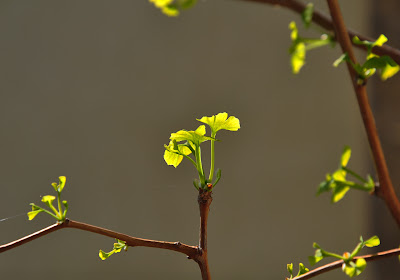I keep a few mature Trichocereus plants that are moved out on the balcony come spring. While the Trichocereus peruvianus (Peruvian Torch cactus) and Trichocereus bridgesii plants usually take the transition to being exposed to the elements in stride, I always have to look out for my Trichocereus pachanoi (San Pedro cactus) not to get sunburned. Like in humans sunburn in cacti is the result of an inflammation/damage of the epidermis caused by excessive exposure to ultraviolet (UV) radiation from sunlight; typically most severe in new growth.

San Pedro cactus developing a sunburn
Consequently I aim to introduce the tender Trichocereus pachanoi gradually to full sun. This spring I made sure to place the San Pedro in an area that lies in shade most of the day. I even heeded the weather reports and moved the plants indoors on sunny days. Still the San Pedro is developing a sunburn in the new growth area facing the sun - interestingly it doesn't seem to get sunburned at the growing point at the tip but always a bit down the side from it, probably because of the steeper angle of incidence of the sun rays and UV radiation.

Undamaged, bright green new San Pedro growth
More severe burns turn into unbecoming, hard tan scars as illustrated by the below picture of last years burn (where I thoughtlessly moved the plants out and placed them in a sunny spot without observing them for a couple of days).

Trichocereus pachanoi with sunburn from last year
A light sunburn can be outgrown but the hard scars are permanent.
I'll end this post on a more positive note with the image below of a Ginkgo biloba happily setting new leaves :-) The Ginkgo biloba grows on the balcony year-round.

Ginkgo biloba ushering in spring
Sunday, May 19, 2013
Sunburned San Pedro cactus (Trichocereus pachanoi)
Tuesday, February 05, 2013
Flowering San Pedro cactus (Trichocereus pachanoi)

Flowering stand of San Pedro cacti (Trichocereus pachanoi)
To me the main draw of the San Pedro cactus (Trichocereus pachanoi (syn. Echinopsis pachanoi)), a fast-growing columnar cactus native to the Andes Mountains of Ecuador and Peru, has always been that it is unsurpassed as a grafting stock. In my opinion it is the perfect rootstock for grafted peyote and similar cacti, as it ensures fast growth and is long-lived.
That being said a towering stand of San Pedro cacti is spectacular in its own right, and the large, beautiful, fragrant flowers are nothing less than awesome!

San Pedro cactus flower bud
I took these pictures last summer but will not disclose the exact location. After peyote (Lophophora williamsii) the San Pedro cactus is one of the most mescaline rich species of cacti and is widely sought after for recreational use - I’m sure the grower of these plants will be quite angry if they are maimed and disfigured by “I, me, mine” types looking for a quick trip. If you are so inclined, grow your own plants.

Spent San Pedro flower
As I said, San Pedro flowers are nothing less than awesome :-)

San Pedro cactus (Trichocereus pachanoi) flower close-up
All Time Most Popular Posts
-
Lophophora williamsii (peyote) populations have diminished in large areas of South Texas where peyoteros harvest the cactus for ceremonial ...
-
On various occasions I've been asked what growing media I'm using for my cactus plants. I don't have a set soil mix recipe as su...
-
Below is a list of retailers/nurseries selling cactus seed and plants. I've only listed vendors I've done business with. If you ar...
-
Most cacti are easily grown from seed - and with a little patience and care they can be grown into beautiful plants. Lophophora williamsi...
-
In last month’s post on the troubled Texan peyoteros I referred to Anderson’s article on the peyote situation in Texas. Given the importanc...
-
Yet another slightly off topic and probably not entirely politically correct post, but I couldn’t help noticing the similarity of my monstr...
-
Flowering stand of San Pedro cacti (Trichocereus pachanoi) To me the main draw of the San Pedro cactus ( Trichocereus pachanoi (syn. Ech...
-
In the June 2008 issue of the Cactus & Co magazine Jaroslav Šnicer, Jaroslav Bohata, and Vojtěch Myšák described a new Lophophora spec...
-
There seems to be an increased focus on the alarming Texas peyote situation. A couple of weeks ago the Houston Press published a mournful, i...
-
I spent two weeks working in Delhi, India during January. I had one weekend off and had planned to spend it in Delhi at my own leisure, but ...


















